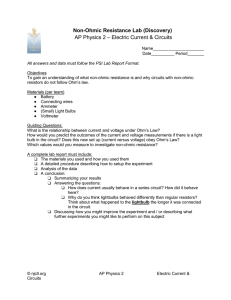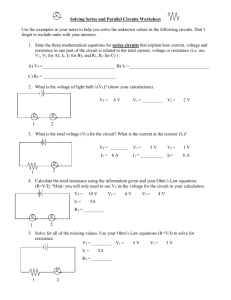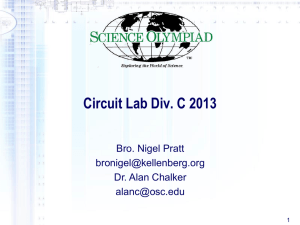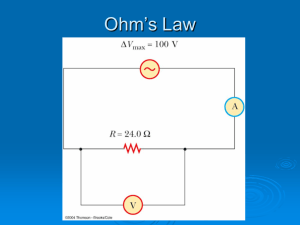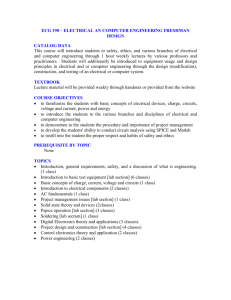CT Thematic lesson plan
advertisement
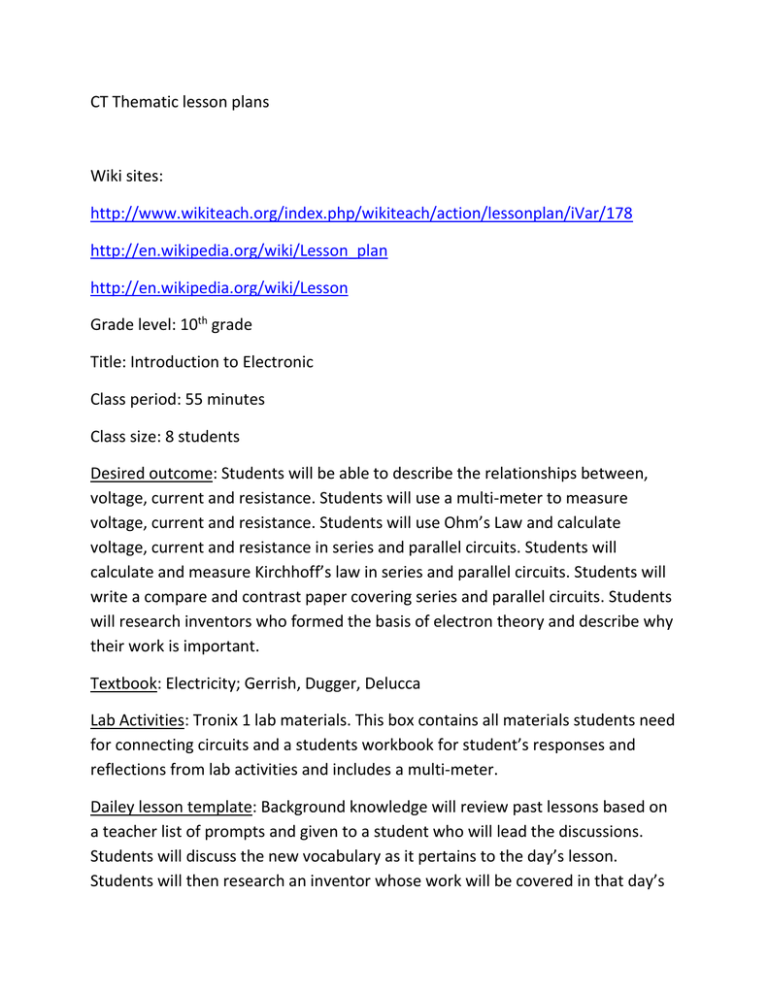
CT Thematic lesson plans Wiki sites: http://www.wikiteach.org/index.php/wikiteach/action/lessonplan/iVar/178 http://en.wikipedia.org/wiki/Lesson_plan http://en.wikipedia.org/wiki/Lesson Grade level: 10th grade Title: Introduction to Electronic Class period: 55 minutes Class size: 8 students Desired outcome: Students will be able to describe the relationships between, voltage, current and resistance. Students will use a multi-meter to measure voltage, current and resistance. Students will use Ohm’s Law and calculate voltage, current and resistance in series and parallel circuits. Students will calculate and measure Kirchhoff’s law in series and parallel circuits. Students will write a compare and contrast paper covering series and parallel circuits. Students will research inventors who formed the basis of electron theory and describe why their work is important. Textbook: Electricity; Gerrish, Dugger, Delucca Lab Activities: Tronix 1 lab materials. This box contains all materials students need for connecting circuits and a students workbook for student’s responses and reflections from lab activities and includes a multi-meter. Dailey lesson template: Background knowledge will review past lessons based on a teacher list of prompts and given to a student who will lead the discussions. Students will discuss the new vocabulary as it pertains to the day’s lesson. Students will then research an inventor whose work will be covered in that day’s lesson and write a 1 paragraph essay to be shared with class. Students will then do a reading out of the text for new information on that day’s lesson. Next students will do lab activities in their tronix 1 box and answers questions in the student workbook and write observations and conclusions. Class will finish with student led discussion about lab activities, observations, inventors contributions and conclusions. Time limits are tentative, depending on discussions and students questions. Lesson 1: Basics of any Electrical Circuits Objectives Science: Students will be able to explain why the unit of measure for Electromotive force (EMF) is called a volt. Student will explain how an electrical current is measured. Student will explain how resistance to currents flow is measured. Math: Student will calculate the resistance of different size and length of wire. Students will properly use the resistor “color code” to determine resistors values with 10% tolerances. Social studies Student will research Allessandro Volta and explain his discovery of voltage Language Student will write 1 paragraph about the discovery of voltage Materials: textbook, Tronix 1 boxes, computer, worksheets, pencil Background Knowledge: What are the 3 parts of an atom? What is the electron theory? What are the differences between a conductor and insulator? What are some examples of each? Explain the law of charges Why does wire come in different sizes? New vocabulary: ampere (A), color code, current flow, electromotive force (EMF), potential difference, voltage and tolerance Activities: (5 min) Discuss background questions-Collaborative Strategy: Hold students accountable to others. A student will be selected to lead a class discussion to review the background questions from the last lesson. (5 min) Discuss new vocabulary--Collaborative Strategies: Code breaking and Building knowledge and vocabulary to advance comprehension. A student will be selected to lead a discussion of new terms pronunciations and meanings and relations to past lessons. (10 min) Research Allessandro Volta and write 1 paragraph of his importance. Strategy: Historical reasoning and argumentative writing (5 min) Read chapter 2- Volts, Amperes, and Ohms. Strategy: using content to draw students into situations that demand higher-order meaning making. After students researches a historical inventor, they will read about that persons ideas in real world applications. (20 min) Lab activities- Strategy: Observation; students will examine different component for polarity to ensure proper connections in circuits, different colors on resistors mean different values, and pictorials of circuits that they will use to connect circuits. 1. Basic circuits 2. Resistor color code 3. Simple circuits 1, 2, and 3 (10 min) Assessments: Collaborative strategy: Instructional Conversations. Student led discussion coving that day’s lab activities and inventor paragraph and how they relate, lab answer sheets, lab circuits, oral teacher questions, clean-up Lesson 2 Reading a Multi-meter Objectives Science: Students will properly connect a multi-meter to different circuits and neasure voltages, currents and resistance. Math: students will select the proper ranges and settings on a multi-meter for accurate circuit measurements Student will do amperage conversions from milliamps to amperes. Social Studies Students will research Jacques d’ Arsonval or Andre-Marie Ampere and explain their contribution to electronics Language Arts Student will write a short essay on the discovery of Amperage Materials: textbook, tronix 1 boxes, computer, worksheets, pencil Background Knowledge: What causes electrons to flow in a circuit? What is this force called? Why? What do we call electrons moving through a circuit? Why? What do we use to control electron flow? How does it work? What are some examples of a load in a circuit? What are the 4 factors of resistance? Explain how color code works. What electrocutes you Volts or Amps? Explain. New vocabulary: ammeter, auto polarity, millimeter, ohmmeter, overload, reflecting galvanometer, shunt, voltmeter and multi-meter Activities (5 min) Discuss background knowledge-Collaborative Strategy: Hold students accountable to others. A student will be selected to lead a class discussion to review the background questions from the last lesson. (5 min) Discuss new vocabulary and relate to background knowledge Collaborative Strategies: Code breaking and Building knowledge and vocabulary to advance comprehension. A student will be selected to lead a discussion of new terms pronunciations and meanings and relations to past lessons. (10 min) Research either Jacques d’ Arsonval or Andre-Marie Ampere and write 1 paragraph of their importance in electronics. Strategy: Historical reasoning and argumentative writing (5 min) Read chapter 3- Reading a Meter. Strategy: using content to draw students into situations that demand higher-order meaning making. After students researches a historical inventor, they will read about that persons ideas in real world applications. (20 min) Lab: Strategy- Strategy: Reliable evidence: Students will be measuring different values of voltage; amperage and resistance with a multi-meter. Students will have to select range setting for accurate readings. Lesson 37 measuring voltage Lesson 38 measuring amperage Lesson 39 measuring resistance (10 min) Assessments: Collaborative strategy: Instructional Conversations. Student led discussion coving that days lab activities and inventor paragraph and how they relate, lab answer sheets, lab circuits, oral teacher questions, clean-up Lesson 3 Ohm’s Law Science: Students describe the relationships between voltage, amps and resistance Students will describe the direct proportions of volts and amps. Students will describe the inverse proportions between volt, amps and resistance. Students will properly calculate voltage, amperage and resistance using Ohm’s Law. Math Students will calculate, then measure voltage, amperage and resistance using Ohm’s Law. Students will design and draw graphs showing their calculations. Social Studies Student will research Georg Ohm and explain his contributions in electronics in a 1 paragraph essay Language Arts Student will write an essay on how changes in voltage, amperage effect resistance Students will list 2 possible reasons for differences between calculations and measurements. Student will write 1 paragraph on how Georg Ohm’s memory device works. Materials: Tronix 1 box, pencil, student workbook, multi-meter Background Knowledge: How does a meter work? Why do we measure Voltage in a parallel connection? Why do we measure amperage in a series connection? Why do we measure resistance in a de-energized circuit? What are the relationships between volts, amps and resistance? If voltage goes up, what happens to amps? Resistance? Why? If voltage goes down, what happens to amps and resistance? Why? If amps go up, what happens to voltage and resistance? Why? If amps go down, what happens to Voltage and resistance? Why? New vocabulary: control, load, voltage source, conductive pathway, switch, milliamps, short circuit, circuit breaker, fuse Activities: (10 min) Discuss background knowledge. Collaborative Strategy: Hold students accountable to others. A student will be selected to lead a class discussion to review the background questions from the last lesson. (5 min) Discuss new vocabulary Collaborative Strategies: Code breaking and Building knowledge and vocabulary to advance comprehension. A student will be selected to lead a discussion of new terms pronunciations and meanings and relations to past lessons. (5 min) Research Georg Ohm and why his law is so important? . Strategy: Historical reasoning and argumentative writing ( 5 min) Read chapter 4- Ohm’s Law- Strategy: using content to draw students into situations that demand higher-order meaning making. After students researches a historical inventor, they will read about that persons ideas in real world applications. (20 min) Activities Ohm’s Law- Strategy- Method of differences. Students will construct circuits and use Ohm’s Law to calculate voltages, amperage and resistance value and compare to measured values using a multi-meter and explain the differences. Experiments 34,35,36 Ohm’s law- Tronix 1 box w/ Ohm’s answer sheet for the following 1. Visual observations of LED brightness 2. Multi-meter readings 3. Ohm’s Law calculations 4. Explain differences between measured and calculated (10 min) Assessments: Collaborative strategy: Instructional Conversations. Student led discussion coving that days lab activities and inventor paragraph and how they relate, lab answer sheets, lab circuits, oral teacher questions, students graphs, clean-up Lesson 4: Series Circuits Objectives Science: Student will properly connect electronic devices in a series circuit. Students will measure voltage, amperage and resistance in a series circuit Math Students will calculate voltage, amperage and resistance in a series circuit Student will calculate voltage drops in series circuit Kirchhoff’s laws Social Studies Students research and describe Gustav Kirchhoff and his importance in the field of electronics Language arts Student will write 2 paragraphs about Kirchhoff’s law, 1 on voltage and 1 on current Student will write a paragraph explaining voltage drops Materials: Tronix 1 box, multi-meter, pencil, multi-meter Background Knowledge Can you draw Ohm’s law memory device and explain how it is used? What are the three basic equations derived from Ohm’s Law? What do the following letters or symbols mean: I, A,V, R, EMF, mA What are the relationships between short circuit and an overload? What do both create? Why is that bad? How are circuit breakers and fuses the same? Different? New Vocabulary: Kirchhoff’s current Law, Kirchhoff’s Voltage Law, voltage drops, series Activities: (10 min) Discuss background Knowledge questions knowledge. Collaborative Strategy: Hold students accountable to others. A student will be selected to lead a class discussion to review the background questions from the last lesson. (5 min) Discuss new vocabulary in relation to background knowledge. Collaborative Strategies: Code breaking and Building knowledge and vocabulary to advance comprehension. A student will be selected to lead a discussion of new terms pronunciations and meanings and relations to past lessons. (5 min) Research Gustav Kirchhoff and explain why his laws are so important today. Strategy: Historical reasoning and argumentative writing (5 min) Read chapter - 6 series circuits Strategy: using content to draw students into situations that demand higher-order meaning making. After students researches a historical inventor, they will read about that persons ideas in real world applications. (20 min) Lab-Kirchhoff’s laws in a series circuit- Strategy: Reliability. Students will construct circuits, calculate voltage, amperage and resistance and verify Kirchhoff’s laws. Then they will measure the voltage, amperage and resistance values to further evaluate Kirchhoff’s laws, doing lessons 39, 40, 41 Tronix 1 box. (10 min) Assessments: Collaborative strategy: Instructional Conversations. Student led discussion coving that day’s lab activities and inventor paragraph and how they relate, lab answer sheets, lab circuits, oral teacher questions, clean-up Lesson 5 Parallel Circuits Objectives Science: Students will properly connect electrical devices forming a parallel circuit. Student will list Kirchhoff’s laws for parallel circuits. Math Students will calculate equivalent resistance Students will calculate equal resistance in parallel circuits’ Students will calculate unequal resistors in parallel circuit. Students will calculate conductance in a parallel circuit. Social Studies Students will research Ernst Werner Von Siemens and explain his contributions in electronics Language Arts Students will write a paragraph about Ernst Werner Von Siemens Material: Tronix 1 box, multi-meter, pencil, multi-meter Background knowledge What are Kirchhoff’s law on series circuits What changes and what stays the same? How is total resistance calculated? What makes a circuit in series? What causes voltage drops in a series circuit? What are resistance drops? How are Christmas tree lights wired? Which type is best? Why? New Vocabulary: conductance, Siemens, parallel, equivalent resistance, reciprocal, branches Activities (10 min) Discuss background knowledge questions knowledge Collaborative Strategy: Hold students accountable to others. A student will be selected to lead a class discussion to review the background questions from the last lesson. (5 min) Relate new vocabulary to background knowledge Collaborative Strategies: Code breaking and Building knowledge and vocabulary to advance comprehension. A student will be selected to lead a discussion of new terms pronunciations and meanings and relations to past lessons. (5 min) research Siemens contributions to electronics. Strategy: Historical reasoning and argumentative writing (5 min) read chapter 7 - Parallel Circuits Strategy: using content to draw students into situations that demand higher-order meaning making. After students researches a historical inventor, they will read about that persons ideas in real world applications. (20 min) Kirchhoff’s Law- parallel circuits. Strategy: Sub arguments. Students will list reasons that parallel circuits differ from series circuits at completion of lab lessons 42, 43, 44 in Tronix 1 box. (10 min) Assessments: Collaborative strategy: Instructional Conversations. Student led discussion coving that days lab activities and inventor paragraph and how they relate, lab answer sheets, lab circuits, oral teacher questions, sub arguments list, clean-up Follow-up activities: Students will use their workbook, inventor paragraphs and graphs to write a short essay to answer the following questions. How do electrons to move in a circuit? Name and explain the 2 reasons circuits have resistance? How are series and parallel circuits different? Write a compare and contrast essay explain why series circuits have voltage drops, yet the amperage remain the same? Explain why parallel circuits’ amperage drops, yet voltage remain the same? Why is resistance calculated differently in series and parallel circuits? What is the importance of Kirchhoff’s laws?


